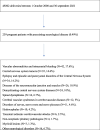Anesthesia for pregnant patients with symptomatic neurological disease: 13 years' experience from a tertiary care center
- PMID: 39833679
- PMCID: PMC11744999
- DOI: 10.1186/s12871-024-02871-5
Anesthesia for pregnant patients with symptomatic neurological disease: 13 years' experience from a tertiary care center
Abstract
Background: Improvements in diagnostics and clinical care have allowed more women of childbearing age, suffering from neurological diseases, to safely have pregnancy, reducing peripartum complications. However, these patients remain at risk and are a constant challenge for anesthesiologists in the delivery room.
Methods: To assess the type of anesthesiologic management performed for delivery in obstetric patients with preexisting neurological disease and who reported significant neurological symptoms during pregnancy, a retrospective observational study was carried out between 1 October 2008 and 30 September 2021.
Results: Data from 49,202 pregnant women were assessed over 13 years; 239 pregnant women with a diagnosis of preexisting neurological disease and who reported significant neurological symptoms during pregnancy were identified (prevalence 0.49%). The main neurological disorders that affected pregnant women included vascular abnormalities and intracranial bleeding (N = 42, 17.6%), central nervous system tumors (N = 35, 14.6%), epilepsy and episodic and paroxysmal disorders of the central nervous system (N = 34, 14.2%), diseases of the neuromuscular junction and muscles (N = 26, 10.9%), demyelinating central nervous system diseases (N = 24, 10%). A total of 234 (97.9%) pregnant women with neurological disorders and significant neurological symptoms underwent cesarean section: 192 (80.3% of the total cesarean sections) were elective, 39 (16.3%) were urgent type 2 and 3; 3 (1.2%) were emergency cesarean sections. General anesthesia was administered to 73 patients (30.5%), while 166 patients (69.5%) were managed with neuraxial techniques. 2 patients who had had neuraxial block reported worsening neurological symptoms that required a change in medical therapy. Postoperative multiparameter monitoring was performed for less than 24 h in the recovery room for 226 patients (94.6%). 3 patients (1.2%) were observed with multiparameter monitoring in the post-anesthesia care unit (PACU) for more than 24 hours; 10 patients (4.2%) were moved to the postoperative intensive care unit (ICU). The median hospitalization duration was 4 days (with an interquartile difference of 3-6 days).
Conclusions: In our experience, when neuraxial anesthesia was feasible, it proved to be a safe option for pregnant patients with symptomatic neurological disease, resulting in uncommon maternal complications.
Keywords: Cesarean section; Neurological disease; Neuromuscular disease; Obstetric anesthesia; Pregnancy.
© 2025. The Author(s).
Conflict of interest statement
Declarations. Ethics approval and consent to participate: This observational retrospective study received approval for data extraction and processing from the Policlinico A. Gemelli Ethics Committee, without ad hoc consent from the enrolled patients (protocol ID 3741). Consent for publication: Not applicable. Competing interests: The authors declare no competing interests.
Figures
Similar articles
-
Maternal and neonatal outcomes of elective induction of labor.Evid Rep Technol Assess (Full Rep). 2009 Mar;(176):1-257. Evid Rep Technol Assess (Full Rep). 2009. PMID: 19408970 Free PMC article.
-
Epidural versus non-epidural or no analgesia for pain management in labour.Cochrane Database Syst Rev. 2018 May 21;5(5):CD000331. doi: 10.1002/14651858.CD000331.pub4. Cochrane Database Syst Rev. 2018. PMID: 29781504 Free PMC article.
-
Assessment and support during early labour for improving birth outcomes.Cochrane Database Syst Rev. 2017 Apr 20;4(4):CD011516. doi: 10.1002/14651858.CD011516.pub2. Cochrane Database Syst Rev. 2017. PMID: 28426160 Free PMC article.
-
Planned early delivery versus expectant management for hypertensive disorders from 34 weeks gestation to term.Cochrane Database Syst Rev. 2017 Jan 15;1(1):CD009273. doi: 10.1002/14651858.CD009273.pub2. Cochrane Database Syst Rev. 2017. PMID: 28106904 Free PMC article.
-
Acupuncture or acupressure for induction of labour.Cochrane Database Syst Rev. 2017 Oct 17;10(10):CD002962. doi: 10.1002/14651858.CD002962.pub4. Cochrane Database Syst Rev. 2017. PMID: 29036756 Free PMC article.
References
-
- van den Bersselaar LR, Heytens L, Silva HCA, Reimann J, Tasca G, Díaz-Cambronero Ó, Løkken N, Hellblom A, Hopkins PM, Rueffert H, Bastian B, Vilchez JJ, Gillies R, Johannsen S, Veyckemans F, Muenster T, Klein A, Litman R, Jungbluth H, Riazi S, Voermans NC, Snoeck MMJ. European Neuromuscular Centre consensus statement on anaesthesia in patients with neuromuscular disorders. Eur J Neurol. 2022;29(12):3486–507. - PMC - PubMed
-
- Guidon AC, Massey EW. Neuromuscular disorders in pregnancy. Neurol Clin. 2012;30(3):889–911. - PubMed
-
- Johnson N, Sermer M, Lausman A. Obstetric outcomes of women with intracranial neoplasms. Int J Gynaecol Obstet. 2009;105(1):56–9. - PubMed
-
- MBRRACE-UK Saving Lives, Improving Mothers’ Care report for 2023. https://www.npeu.ox.ac.uk/assets/downloads/mbrrace-uk/reports/maternal-r.... - PubMed
-
- Toscano M, Thornburg LL. Neurological diseases in pregnancy. Curr Opin Obstet Gynecol. 2019;31(2):97–109. - PubMed
Publication types
MeSH terms
LinkOut - more resources
Full Text Sources
Medical


